Optimisation of Epoxide Ring-Opening Reaction for the Synthesis of Bio-Polyol from Palm Oil Derivative Using Response Surface Methodology
Abstract
1. Introduction
2. Results and Discussions
2.1. Epoxidation of Methyl Oleate (EMO)
Reaction Mechanism of Epoxidation of Methyl Oleate (EMO)
2.2. Ring Opening of Epoxidised Methyl Oleate with Glycerol
2.2.1. Reaction Mechanism of Epoxide Ring-Opening by Glycerol
2.2.2. Single Factor Experiment
Effect of Mole Ratio (EMO:Glycerol) on Hydroxyl Value (OHV)
Effect of Catalyst on Hydroxyl Value (OHV)
Effect of Temperature on Hydroxyl Value (OHV)
2.2.3. Optimisation Reaction Conditions by Response Surface Methodology
Fitting the Model and Analysis of Variance (ANOVA)
Mutual Effects of Process Parameters
2.3. Verification of the Model
2.4. Evaluation of the Importance of the Variables on the Hydroxyl Value (OHV) of Polyol
2.5. Characterisation of Optimised MOG-Polyol
3. Materials and Methods
3.1. Materials
FTIR and NMR Data of Methyl Oleate
3.2. Epoxidation of Methyl Oleate
3.3. Ring-Opening of Epoxidised Methyl Oleate with Glycerol
3.3.1. Single Factor Experiment
3.3.2. Experimental Design and Optimisation via Response Surface Methodology (RSM)
3.3.3. Statistical Analysis
3.4. Verification of the Model
3.5. Characterisation
4. Conclusions
Author Contributions
Funding
Data Availability Statement
Acknowledgments
Conflicts of Interest
References
- Cui, S.; Liu, Z.; Li, Y. Bio-polyols synthesized from crude glycerol and applications on polyurethane wood adhesives. Ind. Crops Prod. 2017, 108, 798–805. [Google Scholar] [CrossRef]
- Vanlede, K.; Kluijtmans, L.A.; Monnens, L.; Levtchenko, E. Urinary excretion of polyols and sugars in children with chronic kidney disease. Pediatr. Nephrol. 2015, 30, 1537–1540. [Google Scholar] [CrossRef] [PubMed]
- Chatterjee, A.; Maity, B.; Ahmed, S.A.; Seth, D. Photophysics and rotational diffusion of hydrophilic molecule in polymer and polyols. J. Phys. Chem. B 2014, 118, 12680–12691. [Google Scholar] [CrossRef] [PubMed]
- Saalah, S.; Abdullah, L.C.; Aung, M.M.; Salleh, M.Z.; Awang Biak, D.R.; Basri, M.; Jusoh, E.R. Waterborne polyurethane dispersions synthesized from jatropha oil. Ind. Crops Prod. 2015, 64, 194–200. [Google Scholar] [CrossRef]
- Prociak, A.; Malewska, E.; Kurańska, M.; Bąk, S.; Budny, P. Flexible polyurethane foams synthesized with palm oil-based bio-polyols obtained with the use of different oxirane ring opener. Ind. Crops Prod. 2018, 115, 69–77. [Google Scholar] [CrossRef]
- Moser, P.; Cornelio, M.L.; Nicoletti Telis, V.R. Influence of the concentration of polyols on the rheological and spectral characteristics of guar gum. LWT 2013, 53, 29–36. [Google Scholar] [CrossRef][Green Version]
- Prociak, A.; Szczepkowski, L.; Ryszkowska, J.; Kurańska, M.; Auguścik, M.; Malewska, E.; Gloc, M.; Michałowski, S. Influence of chemical structure of petrochemical polyol on properties of bio-polyurethane foams. J. Polym. Environ. 2019, 27, 2360–2368. [Google Scholar] [CrossRef]
- Desroches, M.; Escouvois, M.; Auvergne, R.; Caillol, S.; Boutevin, B. From vegetable oils to polyurethanes: Synthetic routes to polyols and main industrial products. Polym. Rev. 2012, 52, 38–79. [Google Scholar] [CrossRef]
- Bakhshi, H.; Yeganeh, H.; Mehdipour-Ataei, S.; Shokrgozar, M.A.; Yari, A.; Saeedi-Eslami, S.N. Synthesis and characterization of antibacterial polyurethane coatings from quaternary ammonium salts functionalized soybean oil based polyols. Mater. Sci. Eng. C Mater. Biol. Appl. 2013, 33, 153–164. [Google Scholar] [CrossRef]
- Arniza, M.Z.; Hoong, S.S.; Idris, Z.; Yeong, S.K.; Hassan, H.A.; Din, A.K.; Choo, Y.M. Synthesis of transesterified palm olein-based polyol and rigid polyurethanes from this polyol. J. Am. Oil Chem. Soc. 2015, 92, 243–255. [Google Scholar] [CrossRef]
- Sabrina, S.; Rohah, A.M.; Rahmat, A.R. Novel palm oil based polyols with amine functionality synthesis via ring opening reaction of epoxidized palm oil. J. Teknol. 2018, 80, 1–7. [Google Scholar]
- Kong, X.; Liu, G.; Curtis, J.M. Characterization of canola oil based polyurethane wood adhesives. Int. J. Adhes. Adhes. 2011, 31, 559–564. [Google Scholar] [CrossRef]
- Hazmi, A.S.A.; Aung, M.M.; Abdullah, L.C.; Salleh, M.Z.; Mahmood, M.H. Producing Jatropha oil-based polyol via epoxidation and ring opening. Ind. Crops Prod. 2013, 50, 563–567. [Google Scholar] [CrossRef]
- Malaysian Palm Oil Board (MPOB). Pocketbook Palm Oil Statistics; Malaysian Palm Oil Board (MPOB): Kajang, Selangor, Malaysia, 2019; pp. 1–29.
- Abril-Milan, D.; Valdes, O.; Mirabal-Gallardo, Y.; Alexander, F.d.l.T.; Bustamante, C.; Contreras, J. Preparation of renewable bio-polyols from two species of Colliguaja for rigid polyurethane foams. Materials 2018, 11, 2244. [Google Scholar] [CrossRef]
- Pillai, P.K.S.; Li, S.; Bouzidi, L.; Narine, S.S. Metathesized palm oil & novel polyol derivatives: Structure, chemical composition and physical properties. Ind. Crops Prod. 2016, 84, 205–223. [Google Scholar] [CrossRef]
- Narine, S.S.; Yue, J.; Kong, X. Production of polyols from canola oil and their chemical identification and physical properties. J. Am. Oil Chem. Soc. 2006, 84, 173–179. [Google Scholar] [CrossRef]
- Garrison, T.F.; Kessler, M.R.; Larock, R.C. Effects of unsaturation and different ring-opening methods on the properties of vegetable oil-based polyurethane coatings. Polymer 2014, 55, 1004–1011. [Google Scholar] [CrossRef]
- Desroches, M.; Caillol, S.; Lapinte, V.; Auvergne, R.m.; Boutevin, B. Synthesis of biobased polyols by thiol-ene coupling from vegetable oils. Macromolecules 2011, 44, 2489–2500. [Google Scholar] [CrossRef]
- Hou, C.T.; Lin, J.-T. Methods for microbial screening and production of polyol oils from soybean oil through bioprocess. Biocatal. Agric. Biotechnol. 2013, 2, 1–6. [Google Scholar] [CrossRef]
- Tuan Ismail, T.N.M.; Ibrahim, N.A.; Mohd Noor, M.A.; Hoong, S.S.; Poo Palam, K.D.; Yeong, S.K.; Idris, Z.; Schiffman, C.M.; Sendijarevic, I.; Abd Malek, E. Oligomeric composition of polyols from fatty acid methyl ester: The effect of ring-opening reactants of epoxide groups. J. Am. Oil Chem. Soc. 2018, 95, 509–523. [Google Scholar] [CrossRef]
- Lim, S.; Teong, L.K. Recent trends, opportunities and challenges of biodiesel in Malaysia: An overview. Renew. Sust. Energ. Rev. 2010, 14, 938–954. [Google Scholar] [CrossRef]
- Azahar, N.F.; Gani, S.S.A.; Mohd Mokhtar, N.F. Optimization of phenolics and flavonoids extraction conditions of Curcuma Zedoaria leaves using response surface methodology. Chem. Cent. J. 2017, 11, 96. [Google Scholar] [CrossRef] [PubMed]
- Izadiyan, Z.; Basri, M.; Fard Masoumi, H.R.; Abedi Karjiban, R.; Salim, N.; Shameli, K. Modeling and optimization of nanoemulsion containing Sorafenib for cancer treatment by response surface methodology. Chem. Cent. J. 2017, 11, 21. [Google Scholar] [CrossRef] [PubMed]
- Pilkington, J.L.; Preston, C.; Gomes, R.L. Comparison of response surface methodology (RSM) and artificial neural networks (ANN) towards efficient extraction of artemisinin from Artemisia annua. Ind. Crops Prod. 2014, 58, 15–24. [Google Scholar] [CrossRef]
- Naresh Yadav, D.; Anand Kishore, K.; Saroj, D. A study on removal of methylene blue dye by photo catalysis integrated with nanofiltration using statistical and experimental approaches. Environ. Technol. 2020, 1–14. [Google Scholar] [CrossRef]
- Lee, P.L.; Wan Yunus, W.M.Z.; Yeong, S.K.; Abdullah, D.K.; Lim, W.H. Optimization of the epoxidation of methyl ester of palm fatty acid distillate. J. Oil Palm Res. 2009, 21, 675–682. [Google Scholar]
- Tajau, R.; Rohani, R.; Wan Isahak, W.N.R.; Salleh, M.Z.; Ghazali, Z. Development of new bio-based polyol ester from palm oil for potential polymeric drug carrier. Adv. Polym. Technol. 2018, 37, 3552–3560. [Google Scholar] [CrossRef]
- Kai Ling, C.; Aung, M.M.; Rayung, M.; Chuah Abdullah, L.; Lim, H.N.; Mohd Noor, I.S. Performance of ionic transport properties in vegetable oil-based polyurethane acrylate gel polymer electrolyte. ACS Omega 2019, 4, 2554–2564. [Google Scholar] [CrossRef]
- Rayung, M.; Aung, M.M.; Ahmad, A.; Su’ait, M.S.; Abdullah, L.C.; Ain Md Jamil, S.N. Characteristics of ionically conducting jatropha oil-based polyurethane acrylate gel electrolyte doped with potassium iodide. Mater. Chem. Phys. 2019, 222, 110–117. [Google Scholar] [CrossRef]
- Saithai, P.; Tanrattanakul, V. Epoxidized soybean oil-PMMA copolymer and nano-titanium dioxide. Adv. Sci. Lett. 2013, 19, 862–865. [Google Scholar] [CrossRef]
- Hoang, T.T.K.; Kim, I. Epoxidation and ring-opening of palm oil to produce high-functionality polyols. Aust. J. Basic Appl. Sci. 2015, 9, 89–93. [Google Scholar]
- Khairudin, N.; Basri, M.; Fard Masoumi, H.R.; Samson, S.; Ashari, S.E. Enhancing theBBioconversion of azelaic acid to its derivatives by response surface methodology. Molecules 2018, 23, 397. [Google Scholar] [CrossRef] [PubMed]
- Kamairudin, N.; Gani, S.S.; Masoumi, H.R.; Hashim, P. Optimization of natural lipstick formulation based on pitaya (Hylocereus polyrhizus) seed oil using D-optimal mixture experimental design. Molecules 2014, 19, 16672–16683. [Google Scholar] [CrossRef]
- Yang, B.; Zhang, M.; Weng, H.; Xu, Y.; Zeng, L. Optimization of ultrasound assisted extraction (UAE) of Kinsenoside compound from Anoectochilus roxburghii (Wall.) Lindl by response surface methodology (RSM). Molecules 2020, 25, 193. [Google Scholar] [CrossRef] [PubMed]
- Samiun, W.S.; Ashari, S.E.; Salim, N.; Ahmad, S. Optimization of processing parameters of nanoemulsion containing Aripiprazole using response surface methodology. Int. J. Nanomed. 2020, 15, 1585–1594. [Google Scholar] [CrossRef]
- Azman, N.Z.M.; Zainal, P.N.S.; Alang Ahmad, S.A. Enhancement the electrochemical conductivity of a modified reduced graphene oxide/calixarene screen-printed electrode using response surface methodology. PLoS ONE 2020, 15, e0234148. [Google Scholar] [CrossRef]
- Roselan, M.A.; Ashari, S.E.; Faujan, N.H.; Mohd Faudzi, S.M.; Mohamad, R. An improved nanoemulsion formulation containing Kojic Monooleate: Optimization, characterization and in vitro studies. Molecules 2020, 25, 2616. [Google Scholar] [CrossRef]
- Che Sulaiman, I.S.; Basri, M.; Fard Masoumi, H.R.; Chee, W.J.; Ashari, S.E.; Ismail, M. Effects of temperature, time, and solvent ratio on the extraction of phenolic compounds and the anti-radical activity of Clinacanthus nutans Lindau leaves by response surface methodology. Chem. Cent. J. 2017, 11, 54. [Google Scholar] [CrossRef]
- Bezerra, M.A.; Santelli, R.E.; Oliveira, E.P.; Villar, L.S.; Escaleira, L.A. Response surface methodology (RSM) as a tool for optimization in analytical chemistry. Talanta 2008, 76, 965–977. [Google Scholar] [CrossRef]
- Jibril, Z.I.; Ramli, A.; Jumbri, K.; Mohamad Yunus, N. Phoenix dactylifera L. seed pretreatment for oil extraction and optimization studies for biodiesel production using Ce-Zr/Al-MCM-41 catalyst. Catalysts 2020, 10, 764. [Google Scholar] [CrossRef]
- Zhang, L.; Cheng, Z.; Guo, X.; Jiang, X.; Liu, R. Process optimization, kinetics and equilibrium of orange G and acid orange 7 adsorptions onto chitosan/surfactant. J. Mol. Liq. 2014, 197, 353–367. [Google Scholar] [CrossRef]
- Yetilmezsoy, K.; Demirel, S.; Vanderbei, R.J. Response surface modeling of Pb(II) removal from aqueous solution by Pistacia vera L.: Box-Behnken experimental design. J. Hazard. Mater. 2009, 171, 551–562. [Google Scholar] [CrossRef] [PubMed]
- Mangili, I.; Lasagni, M.; Huang, K.; Isayev, A.I. Modeling and optimization of ultrasonic devulcanization using the response surface methodology based on central composite face-centered design. Chemometr. Intell. Lab. Syst. 2015, 144, 1–10. [Google Scholar] [CrossRef]
- Soi, H.S.; Kian, Y.S.; Idris, Z. Synthesis of novel oligomeric polyols from epoxidised methyl oleate and epoxidised palm olein for elastic polyurethane products. J. Oil Palm Res. 2017, 29, 401–413. [Google Scholar] [CrossRef]
- Abdullah, A.; Abd Gani, S.S.; Yun Hin, T.Y.; Haiyee, Z.A.; Zaidan, U.H.; Kassim, M.A.; Effendi Halmi, M.I. Lipase-catalyzed synthesis of red pitaya (Hylocereus polyrhizus) seed oil esters for cosmeceutical applications: Process optimization using response surface methodology. RSC Adv. 2019, 9, 5599–5609. [Google Scholar] [CrossRef]
- Sohrabi, M.R.; Amiri, S.; Masoumi, H.R.F.; Moghri, M. Optimization of direct yellow 12 dye removal by nanoscale zero-valent iron using response surface methodology. J. Ind. Eng. Chem. 2014, 20, 2535–2542. [Google Scholar] [CrossRef]
- Ang, K.P.; Lee, C.S.; Cheng, S.F.; Chuah, C.H. Synthesis of palm oil-based polyester polyol for polyurethane adhesive production. J. Appl. Polym. Sci. 2014, 131, 39967. [Google Scholar] [CrossRef]
- Prociak, A.; Kurańska, M.; Cabulis, U.; Ryszkowska, J.; Leszczyńska, M.; Uram, K.; Kirpluks, M. Effect of bio-polyols with different chemical structures on foaming of polyurethane systems and foam properties. Ind. Crops Prod. 2018, 120, 262–270. [Google Scholar] [CrossRef]
- Hoong, S.S.; Arniza, M.Z.; Mariam, N.M.D.N.S.; Armylisas, A.H.N.; Yeong, S.K. Synthesis and physicochemical properties of novel lauric acid capped estolide esters and amides made from oleic acid and their evaluations for biolubricant basestock. Ind. Crops Prod. 2019, 140. [Google Scholar] [CrossRef]
- American Oil Chemists’ Society (AOCS). Acid Value Te 1a-64; Hydroxyl Value Cd 13-60; Iodine Value Cd 1d-92; Oxirane Oxygen Content Cd 9-57. Official Methods and Recommended Practices of the American oil Chemists’ Society, 6th ed.; AOCS Press: Champaign, IL, USA, 2009. [Google Scholar]
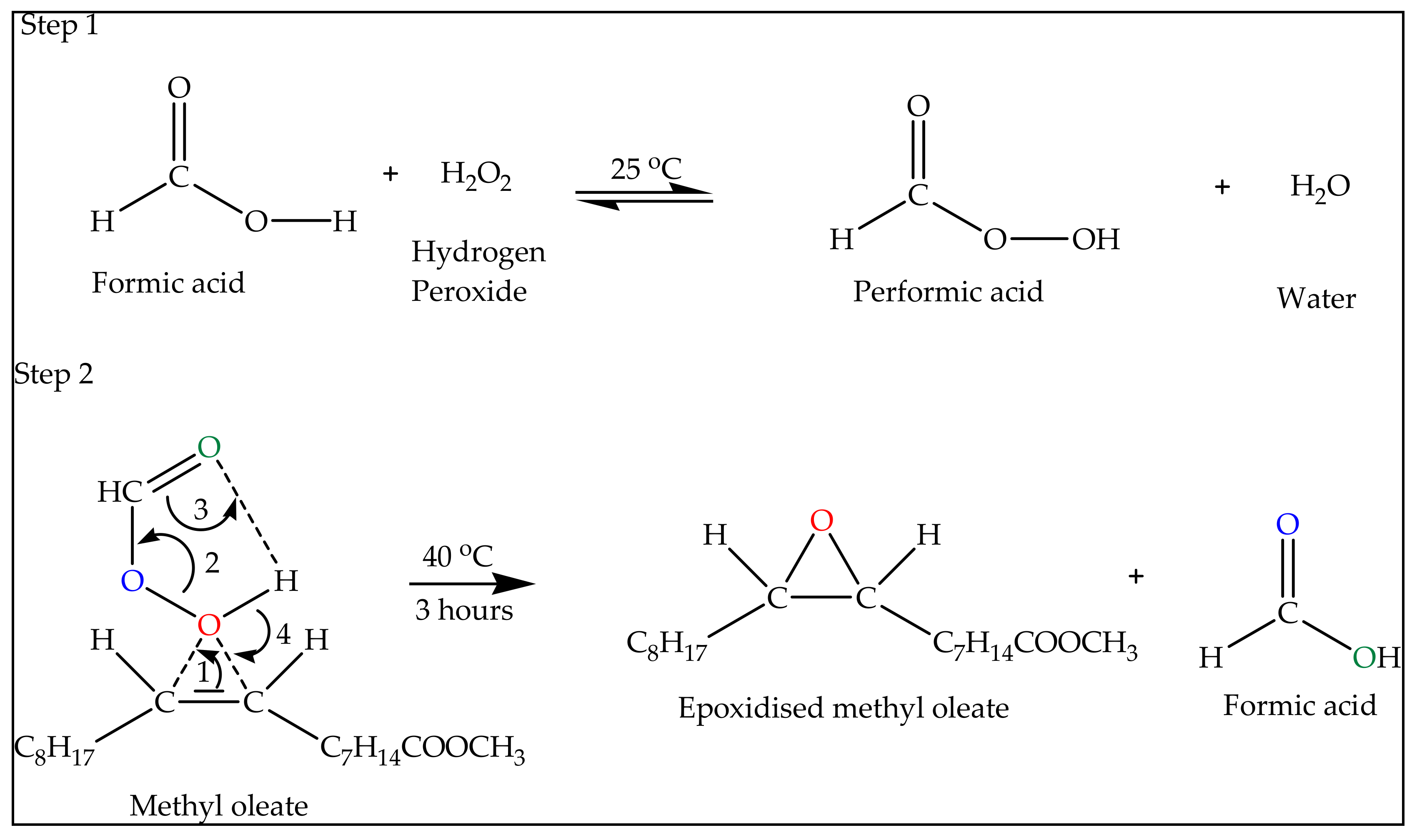
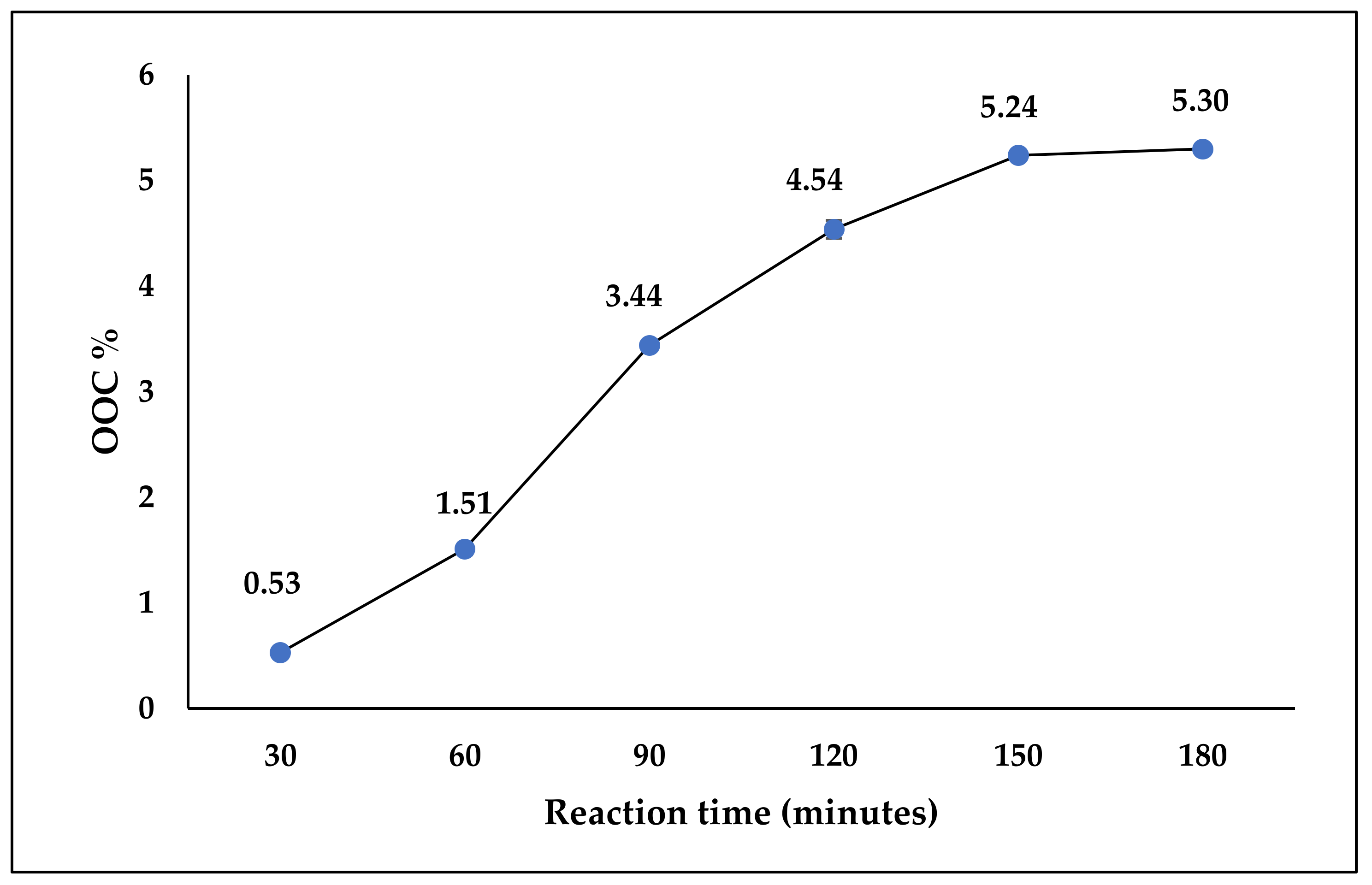
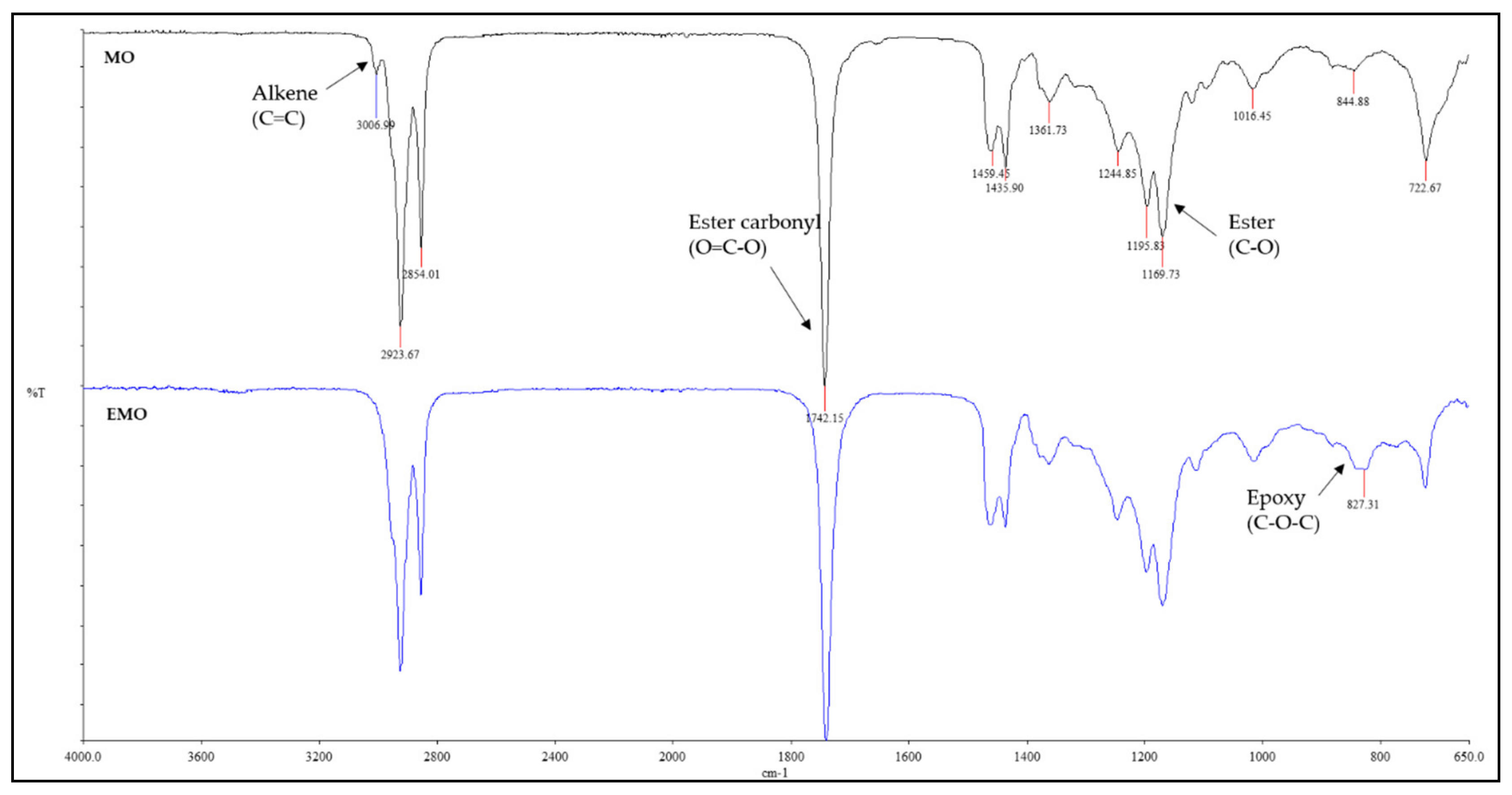
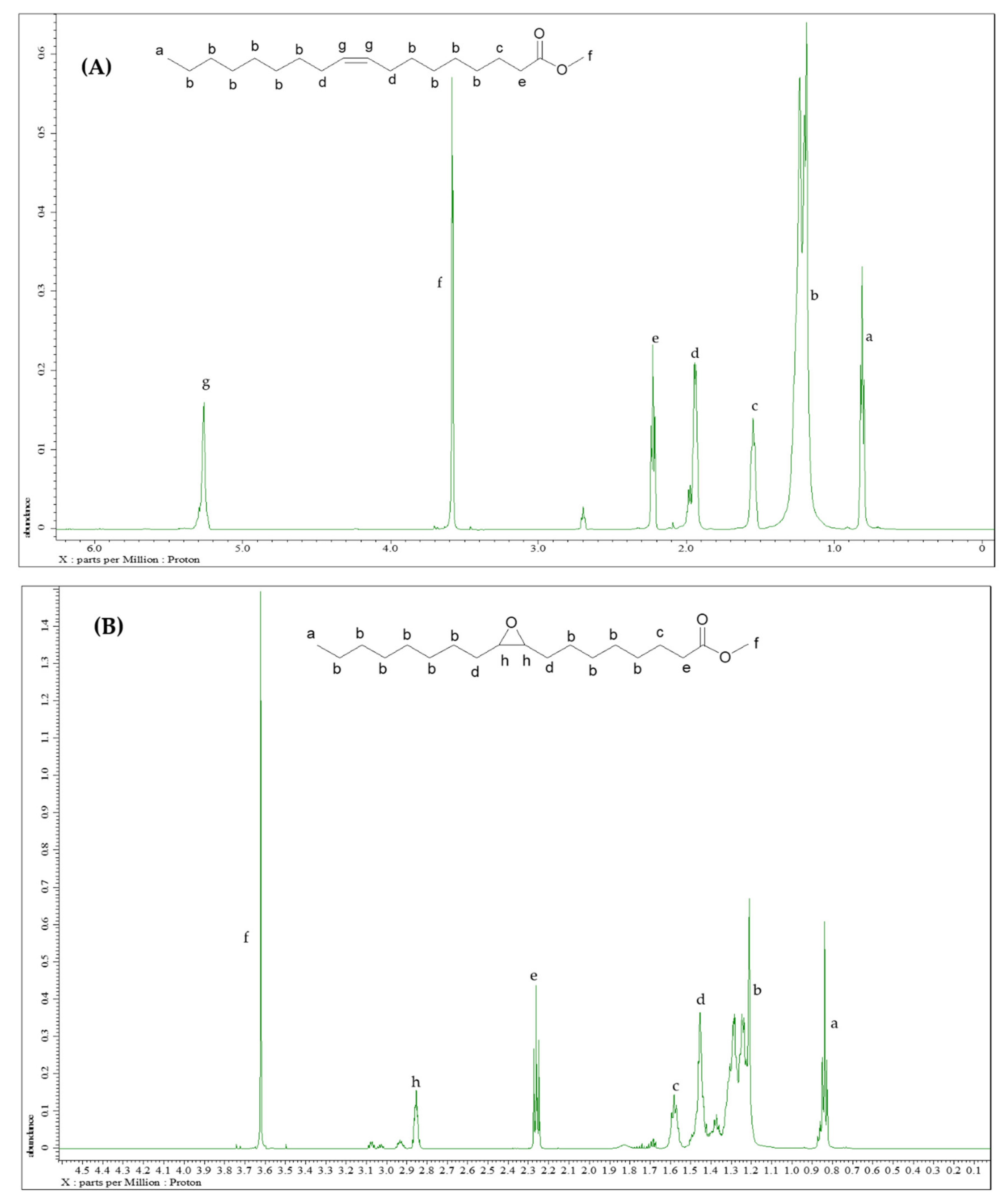
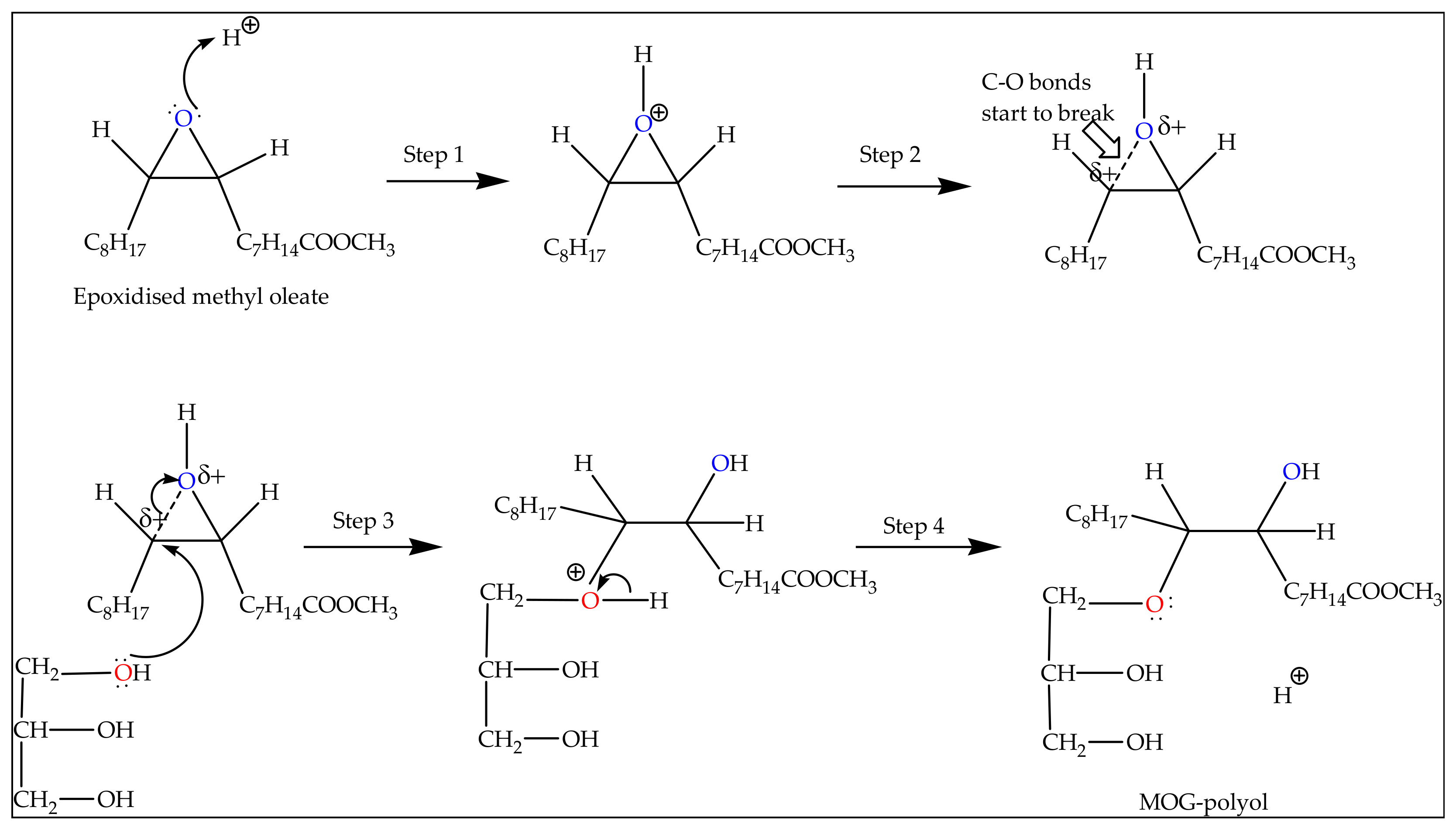
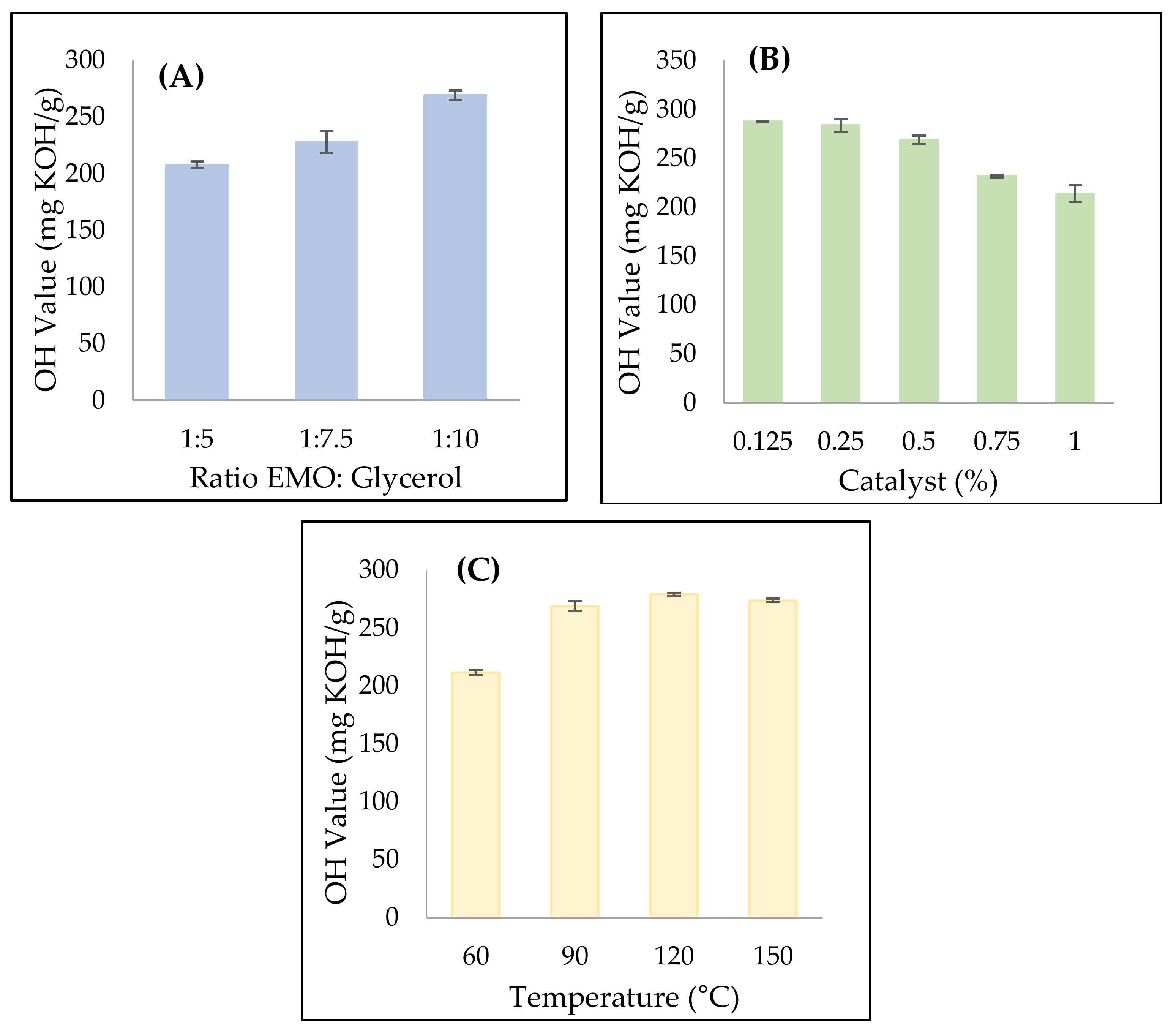
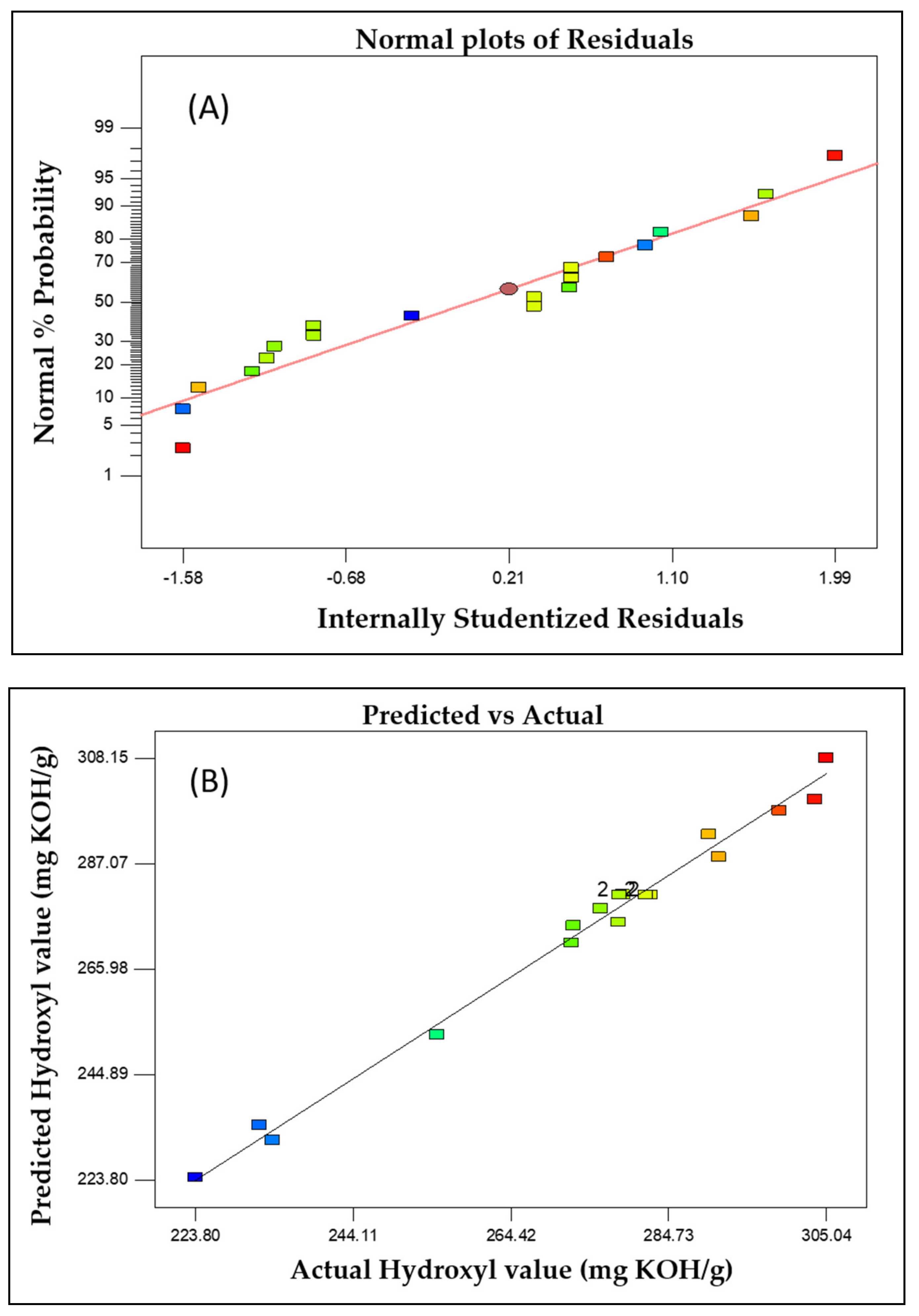
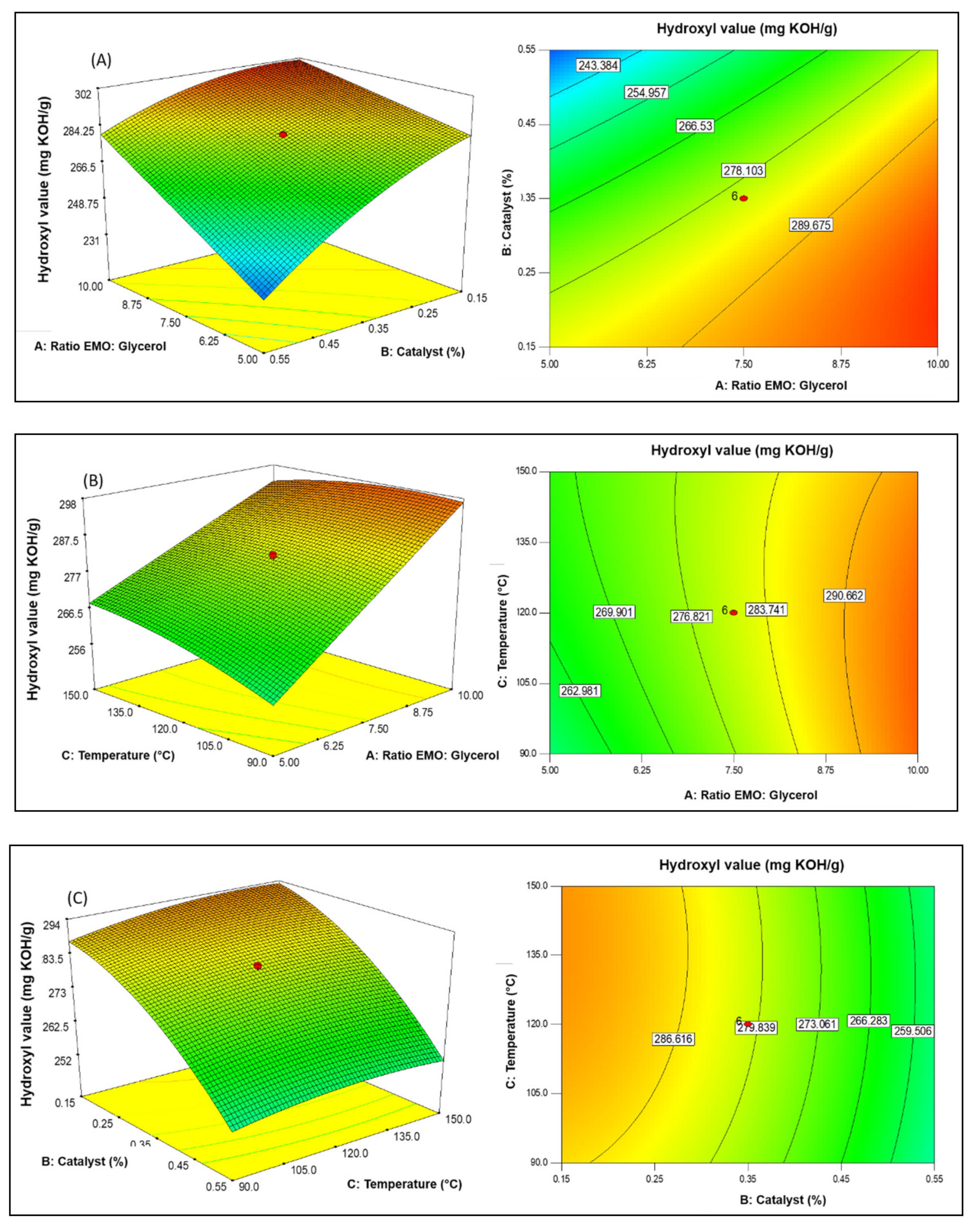
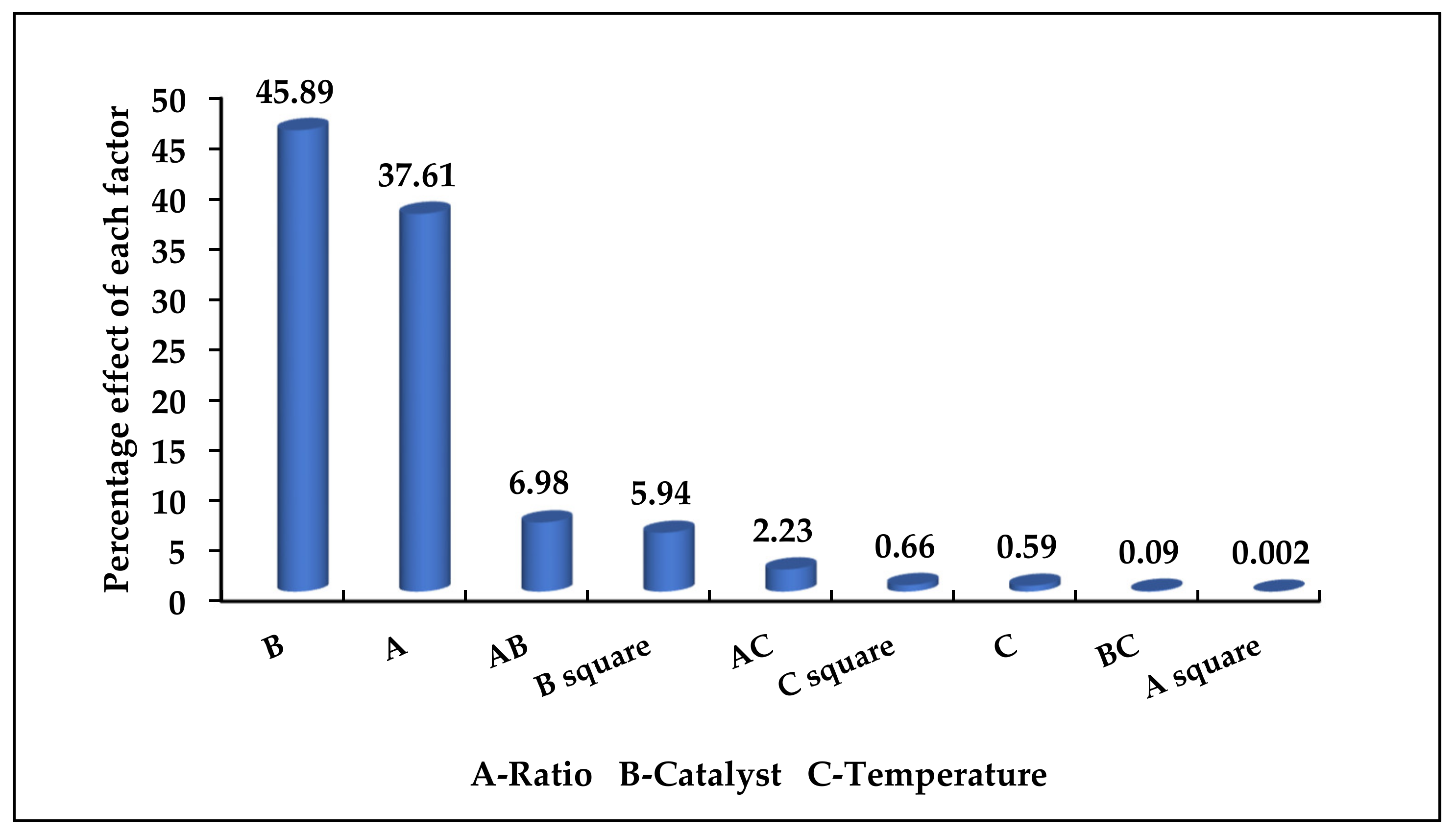
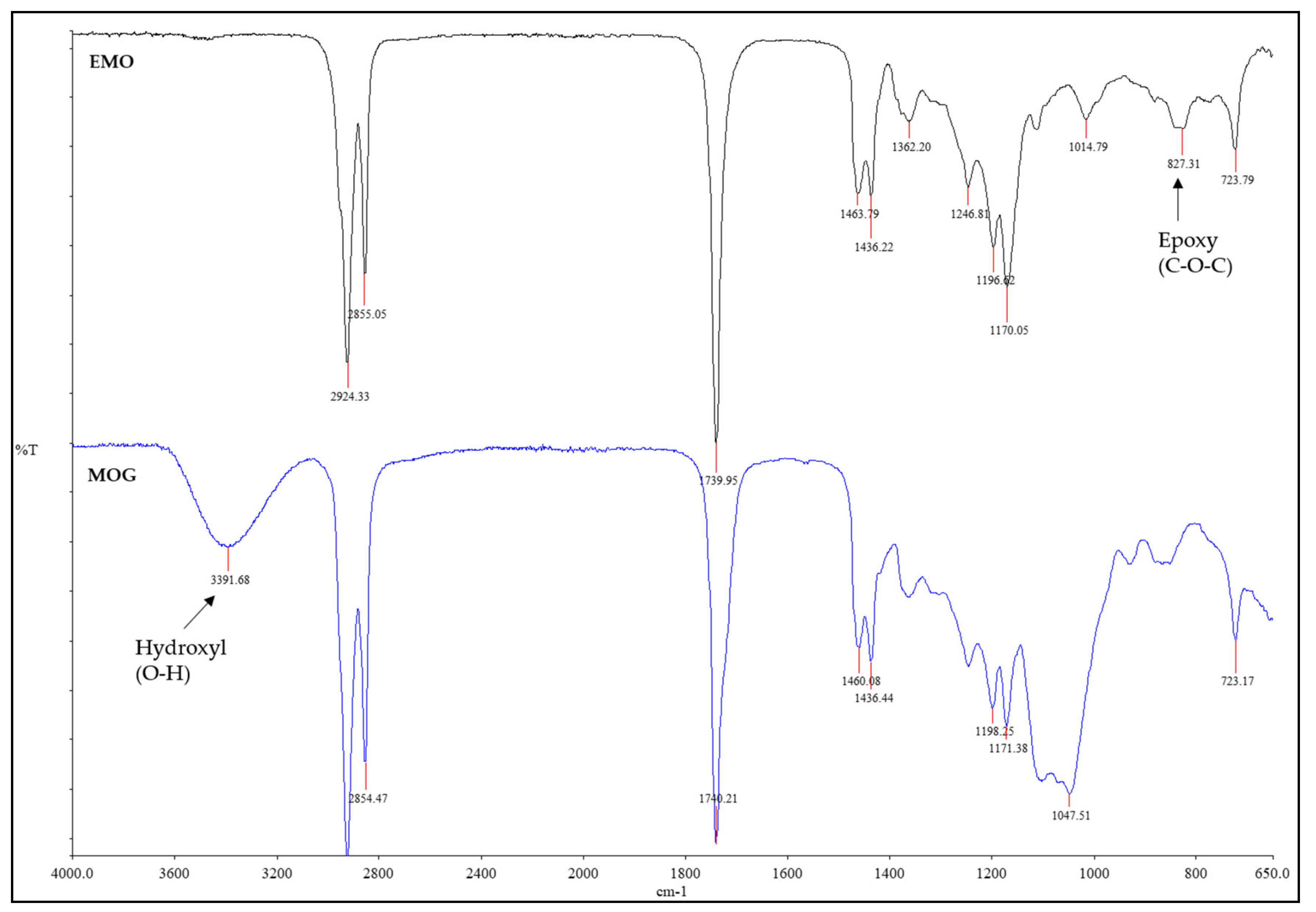

| Independent Variable | Hydroxyl Value (mg KOH/g) | ||||
|---|---|---|---|---|---|
| Run Order | Mole Ratio (EMO:Glycerol) | Catalyst (%) | Temperature (°C) | Actual | Predicted |
| 1 | 1:3.30 | 0.35 | 120.00 | 254.95 | 252.90 |
| 2 | 1:7.50 | 0.35 | 120.00 | 282.40 | 280.83 |
| 3 | 1:5.00 | 0.55 | 150.00 | 232.02 | 234.87 |
| 4 | 1:7.50 | 0.35 | 120.00 | 281.82 | 280.83 |
| 5 | 1:5.00 | 0.15 | 90.00 | 272.51 | 274.68 |
| 6 | 1:7.50 | 0.35 | 69.50 | 272.27 | 271.21 |
| 7 | 1:10.00 | 0.15 | 150.00 | 299.00 | 297.66 |
| 8 | 1:10.00 | 0.15 | 90.00 | 303.53 | 299.92 |
| 9 | 1:7.50 | 0.35 | 120.00 | 282.40 | 280.83 |
| 10 | 1:7.50 | 0.35 | 120.00 | 278.35 | 280.83 |
| 11 | 1:7.50 | 0.69 | 120.00 | 233.72 | 231.84 |
| 12 | 1:7.50 | 0.35 | 120.00 | 281.82 | 280.83 |
| 13 | 1:7.50 | 0.35 | 120.00 | 278.35 | 280.83 |
| 14 | 1:11.70 | 0.35 | 120.00 | 305.04 | 308.15 |
| 15 | 1:10.00 | 0.55 | 90.00 | 278.83 | 280.85 |
| 16 | 1:7.50 | 0.01 | 120.00 | 289.95 | 292.89 |
| 17 | 1:10.00 | 0.55 | 150.00 | 278.26 | 275.34 |
| 18 | 1:5.00 | 0.55 | 90.00 | 223.80 | 224.39 |
| 19 | 1:5.00 | 0.15 | 150.00 | 291.19 | 288.41 |
| 20 | 1:7.50 | 0.35 | 170.50 | 275.99 | 278.12 |
| Source | Sum of Squares | df | Mean Square | F-Value | p-Value | Significant |
|---|---|---|---|---|---|---|
| Model | 9517.62 | 9 | 1057.51 | 106.47 | <0.0001 | * |
| A | 3685.25 | 1 | 3685.25 | 371.04 | <0.0001 | * |
| B | 4499.43 | 1 | 4499.43 | 453.02 | <0.0001 | * |
| C | 57.64 | 1 | 57.64 | 5.8 | 0.0367 | ** |
| AB | 487.34 | 1 | 487.34 | 49.07 | <0.0001 | * |
| AC | 128 | 1 | 128 | 12.89 | 0.0049 | * |
| BC | 5.28 | 1 | 5.28 | 0.53 | 0.4826 | *** |
| A2 | 0.16 | 1 | 0.16 | 0.016 | 0.9014 | *** |
| B2 | 613.76 | 1 | 613.76 | 61.79 | <0.0001 | * |
| C2 | 68.43 | 1 | 68.43 | 6.89 | 0.0254 | ** |
| Residual | 99.32 | 10 | 9.93 | |||
| Lack of Fit | 80.14 | 5 | 16.03 | 4.18 | 0.0714 | *** |
| Pure Error | 19.19 | 5 | 3.84 | |||
| Corrected Total | 9616.94 | 19 |
| SD | 3.15 | R2 | 0.9897 |
| Mean | 274.81 | Adjusted R2 | 0.9804 |
| CV% | 1.15 | Predicted R2 | 0.9296 |
| PRESS | 677.12 | Adequate Precision | 37.588 |
| Independent Variables | Goal | Lower Limit | Upper Limit |
|---|---|---|---|
| Mole ratio (A) | In range | 5.00 | 10.00 |
| Catalyst (B) | In range | 0.15 | 0.55 |
| Temperature (C) | In range | 90.00 | 150.00 |
| Hydroxyl value | Maximise | 223.80 | 305.04 |
| Exp | Independent Variable | Hydroxyl Value (mg KOH/g) | RSE (%) | |||
|---|---|---|---|---|---|---|
| A | B (%) | C (°C) | Actual | Predicted | ||
| 1 | 1:10.00 | 0.18 | 120 | 306.19 | 301.248 | 1.64 |
| 2 | 1:10.00 | 0.19 | 120 | 304.06 | 301.246 | 0.93 |
| 3 | 1:10.00 | 0.20 | 120 | 303.03 | 301.225 | 0.60 |
| Independent Variable | Hydroxyl Value (mg KOH/g) | Desirability | |||
|---|---|---|---|---|---|
| A | B (%) | C (°C) | Actual | Predicted | |
| 1:10.00 | 0.18 | 120 | 306.19 | 301.248 | 0.976 |
| Parameter | MO | EMO | MOG-Polyol |
|---|---|---|---|
| Iodine value (g I2 100/g) | 91.86 | 0.63 | nd |
| Oxirane oxygen content (%) | nd | 5.10 | 0.05 |
| Acid value (mg KOH/g) | 1.12 | 1.16 | 1.18 |
| Hydroxyl value (mg KOH/g) | 16.50 | 20.60 | 306.19 |
| Viscosity at 25 °C (m Pa) | 5.49 | 13.59 | 513.48 |
| Average molecular weight, MW (Da) | 315 | 297 | 488 |
| Polydispersity Index | 1.0096 | 1.0175 | 1.1402 |
| Independent Variable | Units | Coded Level | ||||
|---|---|---|---|---|---|---|
| −2 | −1 | 0 | +1 | +2 | ||
| A | - | 3.30 | 5.00 | 7.50 | 10.00 | 11.70 |
| B | % | 0.01 | 0.15 | 0.35 | 0.55 | 0.69 |
| C | °C | 69.50 | 90.00 | 120.00 | 150.00 | 170.50 |
| Independent Variable | |||
|---|---|---|---|
| Run Order | Mole Ratio (EMO:Glycerol) | Catalyst (%) | Temperature (°C) |
| 1 | 1:3.30 | 0.35 | 120.00 |
| 2 | 1:7.50 | 0.35 | 120.00 |
| 3 | 1:5.00 | 0.55 | 150.00 |
| 4 | 1:7.50 | 0.35 | 120.00 |
| 5 | 1:5.00 | 0.15 | 90.00 |
| 6 | 1:7.50 | 0.35 | 69.50 |
| 7 | 1:10.00 | 0.15 | 150.00 |
| 8 | 1:10.00 | 0.15 | 90.00 |
| 9 | 1:7.50 | 0.35 | 120.00 |
| 10 | 1:7.50 | 0.35 | 120.00 |
| 11 | 1:7.50 | 0.69 | 120.00 |
| 12 | 1:7.50 | 0.35 | 120.00 |
| 13 | 1:7.50 | 0.35 | 120.00 |
| 14 | 1:11.70 | 0.35 | 120.00 |
| 15 | 1:10.00 | 0.55 | 90.00 |
| 16 | 1:7.50 | 0.01 | 120.00 |
| 17 | 1:10.00 | 0.55 | 150.00 |
| 18 | 1:5.00 | 0.55 | 90.00 |
| 19 | 1:5.00 | 0.15 | 150.00 |
| 20 | 1:7.50 | 0.35 | 170.50 |
Sample Availability: Samples of the bio-polyol are available from the authors. |
Publisher’s Note: MDPI stays neutral with regard to jurisdictional claims in published maps and institutional affiliations. |
© 2021 by the authors. Licensee MDPI, Basel, Switzerland. This article is an open access article distributed under the terms and conditions of the Creative Commons Attribution (CC BY) license (http://creativecommons.org/licenses/by/4.0/).
Share and Cite
Kamairudin, N.; Hoong, S.S.; Abdullah, L.C.; Ariffin, H.; Biak, D.R.A. Optimisation of Epoxide Ring-Opening Reaction for the Synthesis of Bio-Polyol from Palm Oil Derivative Using Response Surface Methodology. Molecules 2021, 26, 648. https://doi.org/10.3390/molecules26030648
Kamairudin N, Hoong SS, Abdullah LC, Ariffin H, Biak DRA. Optimisation of Epoxide Ring-Opening Reaction for the Synthesis of Bio-Polyol from Palm Oil Derivative Using Response Surface Methodology. Molecules. 2021; 26(3):648. https://doi.org/10.3390/molecules26030648
Chicago/Turabian StyleKamairudin, Norsuhaili, Seng Soi Hoong, Luqman Chuah Abdullah, Hidayah Ariffin, and Dayang Radiah Awang Biak. 2021. "Optimisation of Epoxide Ring-Opening Reaction for the Synthesis of Bio-Polyol from Palm Oil Derivative Using Response Surface Methodology" Molecules 26, no. 3: 648. https://doi.org/10.3390/molecules26030648
APA StyleKamairudin, N., Hoong, S. S., Abdullah, L. C., Ariffin, H., & Biak, D. R. A. (2021). Optimisation of Epoxide Ring-Opening Reaction for the Synthesis of Bio-Polyol from Palm Oil Derivative Using Response Surface Methodology. Molecules, 26(3), 648. https://doi.org/10.3390/molecules26030648






